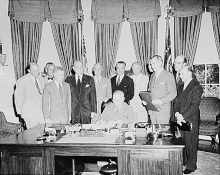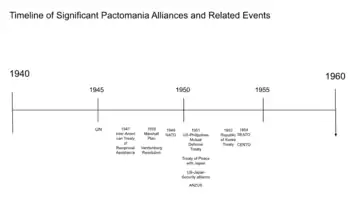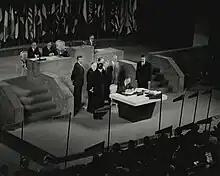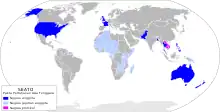
Pactomania is a term originally created to describe a short period of time during which the United States concluded or ratified a significant amount of alliances, treaties, and pacts. The word was first used in a New York Times article in 1955.[1] Now, it refers to the time period from 1945 to 1955 at the beginning of the Cold War. America joined 42 alliances and agreed to nearly 100 treaties. It was a feature of President Harry S. Truman and Dwight D. Eisenhowers’ Cold War strategy,[2] influenced most by figures John Marshall,[3] John Foster Dulles,[4] and Senator Arthur Vandenburg.[5]
End of Isolationism
Prior to this bout of "Pactomania" the United States was described by historians as interventionist in the case of world affairs, but isolationist in the case of alliances. It is often argued by political scientists such as Bear Braumoeller that the U.S. used other methods, particularly financial, to exert its influence over the world. Meanwhile, it avoided outside alliances, treaties, and pacts.[6] Engaging with other countries’ affairs was discouraged in George Washington’s farewell address and the Monroe Doctrine.[7] It had been followed in American foreign policy, with the exception of the world wars. As the Cold War divided the world into two, both the Soviet Union and the United States sought to grow their alliances.
John Foster Dulles
John Foster Dulles was the Secretary of State to President Dwight D. Eisenhower,[7] and a senator for a brief period.[8] Due to his values and experience from his career in law, he believed in the advantages of treaties to fight communist forces in the Cold War. He employed this strategy throughout his career such as in 1945, helping create the UN Charter and in 1954 the Southeast Asia Treaty Organization (SEATO) and Central Treaty Organization (CENTO).[7] Before his death, he contributed to the creation of the Eisenhower Doctrine.[8] John Foster Dulles demonstrated the importance of treaties to United States foreign policy.
Significant alliances and events

United Nations (1945)
One of the biggest alliances was the creation of the United Nations, an international organization created at the end of World War II, to promote peace and curtail war. It was made to replace the League of Nations.[9] Former United States President Woodrow Wilson helped found the League after the First World War, but it was never joined by the U.S.[10]
President Franklin D. Roosevelt proposed the idea of the UN to Soviet Premier Joseph Stalin in November 1943. It was jointly discussed with and proposed by China, the USSR, the United Kingdom, and the United States.[11]
The Declaration of the United Nations was crafted in 1942 at the Arcadia Conference, but the organization was officially created with the signing of the U.N. Charter in 1945. Both of these events took place in U.S. cities.[9] At the time the UN was founded, U.S. President Harry Truman's aim was to increase America's participation in international organizations,[12] which is why it was one of the founding members, and the first country to ratify the Charter.[13] Through the creation of the UN Charter, six smaller organizations, called "Organs" were created to handle separate affairs
Inter-American Treaty of Reciprocal Assistance (1947)
.svg.png.webp)
The idea to create this treaty, also known as the Rio Treaty, had been discussed since the late 1930s when the leaders of the Americas met in several South American cities. However, the countries could not agree due to hesitance from the U.S. and Uruguay. When Senator Vandenburg publicly espoused the idea in a 1947 speech, and the Senate accepted it, nations could sign the Treaty in Rio de Janeiro.[14] Initially, there were 20 members to the Rio Treaty: Argentina, Bolivia, Brazil, Chile, Colombia, Costa Rica, Cuba, Dominican Republic, El Salvador, Guatemala, Haiti, Honduras, Mexico, Panama, Paraguay, Peru, United States, Uruguay and Venezuela.[15] In 1964 Cuba was suspended, due to its support of communism.[16]
The purpose of the treaty was that in the event of an attack on a member, the other would be obliged to come to their defence, on request.[14] Nowadays, aside from the occasional implementation, such as the U.S.’s request for support after the 9/11 attacks, the treaty has fallen into disuse.[17] The Rio Pact influenced the creation of the Vandenburg Resolution, and then, The North Atlantic Treaty Organization (NATO).[14][5]
The Marshall Plan (1948)
In the wake of the Second World War, several European countries were considered to be in shambles with their economies collapsed. Cities were not able to produce enough goods to trade with resource-producing areas and unable to feed their citizens. The Soviet Union took control of Eastern Europe, which threatened Western Europe.
The "Marshall Plan" was suggested by U.S. Secretary of State John Marshall in 1947. The intention was for the U.S. to provide financially for Europe to rebuild its economic infrastructure. It would also help prevent further communist expansion by the Soviets.[18]

The Vandenburg Resolution (1948)
Arthur H. Vandenburg was a Republican Senator, a former candidate for presidential nominee, and an avid supporter of multilateralism.[5] The Vandenburg Resolution was created in 1948, after the Rio Treaty and Marshall Plan. These previous agreements, supported by the Vandenburg Resolution, gave the U.S. the idea to create a similar collective defence agreement with Europe to prevent Soviet control. It pushed the country to create NATO and demonstrated the importance of international agreements to the country.[19] Vandenburg’s draft resolution was introduced to the Senate on June 11, 1948, where it was approved.[5]
NATO (1948)
The North Atlantic Treaty Organization is a collective defence treaty that was created to maintain peace in the North Atlantic region. The treaty included a few features, but the most prominent was the aspect of collective defense.[20] At the time, the United States and European nations were worried about the expansion of the Soviet Union. A collective defense agreement would protect nations from being defenseless in the face of a Soviet invasion.[21] The initial idea for the organization was suggested in the Vandenburg Resolution.[5] In 1948, America, Canada, & Britain began to brainstorm NATO. 12 members signed the treaty in 1949 in Washington, DC, United States.[21]
ANZUS (1951)
ANZUS, signed in 1951 between Australia, New Zealand, and the U.S., was not considered a mutual defence treaty, but was more akin to "mutual aid". Similar to the other treaties in the period of Pactomania, ANZUS was a collective security treaty, where in the event of an attack on one of the members, the conflict would be settled by peaceful means.[22]
The U.S. deemed the idea unnecessary until the three nations shared their concerns regarding the spread of communism.[23] The idea for the alliance was proposed by the U.S. towards Australia, and was extended to New Zealand.
The alliance has never been formally concluded, but in 1984, when New Zealand banned nuclear weapons, the United States cut ties, treaty-wise, with New Zealand.[22]

Treaty of Peace with Japan and US-Japan Security Treaty (1951)
The Japanese Peace Treaty was created after WWII to end war with Japan. It also settled some land disputes with China, Japan, the Soviet Union, and the United States, and compensate people who were harmed in the war. However, it didn't guarantee that foreign military occupation would leave Japan. It was signed in San Francisco, California, United States on September 8, 1951.[24] Shortly after that, the US and Japan created a mutual security treaty.[25]
US-Philippines Mutual Defence Treaty (1951)
This treaty was made to maintain peace in the Philippines and surrounding Pacific Region.[26] It is a bilateral defense agreement, denoting that if either of the nations were to be put in danger, the other would be allowed to use military force to come to their aid. The U.S. and the Philippines have been allies and maintained the treaty since it was created. It is one of the longest-lasting mutual defense treaties in the world.[27]
Republic of Korea Treaty (1953)
The Republic of Korea Treaty is a bilateral defense agreement between the United States and South Korea. Similar to ANZUS, if either of the members faced conflict, the other would defend them using peaceful methods, including defensive military approaches. The treaty was signed in 1953 following the Korean War. The United States and South Korea held the same democratic values. The purpose is to offer South Korea protection from the two nations’ common enemy, the Democratic People's Republic of Korea (DPRK).[28]
SEATO (1954)

The Southeast Asia Treaty Organization (SEATO), also known as the Manila Pact, was a defence treaty made between several countries inside and outside of South Asia. Its purpose was to protect against the spread of communism in Southeast Asia and to help improve conditions in the region.The original members included the United States, France, Great Britain, New Zealand, Australia, the Philippines, and Thailand. There are also "observer" countries, who were still protected under the pact, but could not influence it in other ways.[29]
The organization was officially created in Manila, Philippines in 1955, hence the name.[30] Its headquarters were located in Bangkok, Thailand. SEATO split in 1977.[29]
CENTO (1955)
CENTO was a mutual security treaty to contribute to peace in the Middle East.[31] The United States produced the idea for the pact,[32] but remained an observer to it for the duration of the pact's existence.[33] The title of the treaty has been changed from Baghdad Pact to METO and was re-located and renamed CENTO after tensions between the organization and Arab States, particularly Iraq.[31] After the overthrowing of the Shah in the Iranian Revolution, CENTO ended in 1979.[33]
See also
- Cold War
- Soviet Union
- John Marshall
- John Foster Dulles
- Arthur Vandenburg
- Harry Truman
- Dwight Eisenhower
- United Nations
- Rio Treaty
- Marshall Plan
- Vandenburg Resolution
- NATO
- US-Philippines Mutual Defense Treaty
- Treaty of San Francisco
- US-Japan Security Alliance
- ANZUS
- Republic of Korea Treaty
- SEATO
- CENTO
References
- ↑ Cyrus Leo, Sulzberger (November 23, 1955). "Foreign Affairs; Does the U. S. Suffer From Pactomania?". The New York Times. p. 22. Retrieved January 11, 2024.
- ↑ Friedberg, Aaron L. (1988). "The Making of American National Strategy, 1948-1988". The National Interest (11): 65–75. ISSN 0884-9382.
- ↑ "Marshall Plan (1948)". National Archives. 2021-09-28. Retrieved 2024-01-10.
- ↑ "John Foster Dulles | US Secretary of State, Cold War Diplomat | Britannica". www.britannica.com. 2023-12-18. Retrieved 2024-01-10.
- 1 2 3 4 5 "April 1999 NATO, The Origins of". 1997-2001.state.gov. Retrieved 2024-01-10.
- ↑ "Excerpt: Isolationism". Council on Foreign Relations. Retrieved 2024-01-10.
- 1 2 3 "Isolationism | Definition & Facts | Britannica". www.britannica.com. 2023-12-02. Retrieved 2024-01-10.
- 1 2 "Biographies of the Secretaries of State: John Foster Dulles (1888-1959)". Office of the Historian. January 10, 2023. Retrieved January 10, 2024.
- 1 2 Nations, United. "History of the United Nations". United Nations. Retrieved 2024-01-10.
- ↑ Howard, Lise Morjé (2010). "Sources of Change in United States-United Nations Relations". Global Governance. 16 (4): 485–503. ISSN 1075-2846.
- ↑ "The Formation of the United Nations, 1945". January 10, 2024. Retrieved January 10, 2023.
- ↑ Swift, Richard N. (1958). "United States Leadership in the United Nations". The Western Political Quarterly. 11 (2): 183–194. doi:10.2307/444400. ISSN 0043-4078.
- ↑ "United Nations Treaty Collection". treaties.un.org. Retrieved 2024-01-10.
- 1 2 3 Kunz, Josef L. (1948). "The Inter-American Treaty of Reciprocal Assistance". The American Journal of International Law. 42 (1): 111–120. doi:10.2307/2193568. ISSN 0002-9300.
- ↑ "The Rio Pact at a Glance". The New York Times. April 21, 1982. Retrieved January 10, 2024.
- ↑ https://crsreports.congress.gov/product/pdf/IN/IN11116#:~:text=The%20Rio%20Treaty%2C%20which%20was,provided%20its%20advice%20and%20consent
- ↑ "Hemispheric Security". U.S. Mission to the Organization of American States. Retrieved 2024-01-10.
- ↑ "Marshall Plan (1948)". National Archives. 2021-09-28. Retrieved 2024-01-10.
- ↑ "My Country and Nato". North Atlantic Treaty Organization. Jan 10, 2024. Retrieved Jan 10, 2024.
- ↑ NATO. "Founding treaty". NATO. Retrieved 2024-01-10.
- 1 2 "North Atlantic Treaty Organization (NATO), 1949". Office of the Historian. December 10, 2023. Retrieved December 10, 2023.
- 1 2 "ANZUS Pact". www.britannica.com. January 8, 2024. Retrieved January 8, 2024.
- ↑ "The Australia, New Zealand and United States Security Treaty (ANZUS Treaty), 1951". Office of the Historian. January 8, 2024. Retrieved January 8, 2024.
- ↑ "Joint Compendium of Documents on the History of Territorial Issue between Japan and Russia". Ministry of Foreign Affairs of Japan. March 1, 2001. Retrieved January 9, 2023.
- ↑ "Japan-U.S. Security Treaty". Ministry of Foreign Affairs of Japan. January 8, 2024. Retrieved January 8, 2024.
- ↑ "Mutual Defense Treaty Between the United States and the Republic of the Philippines; August 30, 1951". Yale Law School Lillian Goldman Law Library. August 30, 1951. Retrieved January 8, 2024.
- ↑ Perez-Rubio, Bella (January 28, 2021). "US reaffirms commitment to Mutual Defense Treaty with Philippines". Philstar Global. Retrieved January 8, 2024.
- ↑ "U.S. Collective Defense Arrangements". US Department of State. January 20, 2009. [archive-https://2009-2017.state.gov/s/l/treaty/collectivedefense/#:~:text=A%20treaty%20signed%20August%2030,accordance%20with%20its%20constitutional%20processes Archived] from the original on January 20, 2017. Retrieved December 10, 2023.
- 1 2 "Southeast Asia Treaty Organization (SEATO), 1954". Office of the Historian. January 8, 2024. Retrieved January 8, 2024.
- ↑ "Southeast Asia Treaty Organization (SEATO)". Britannica Kids. Retrieved 2024-01-10.
- 1 2 "Baghdad Pact". Britannica Kids. Retrieved January 8, 2024.
- ↑ [archive-https://2001-2009.state.gov/r/pa/ho/time/lw/98683.htm "The Baghdad Pact (1955) and the Central Treaty Organization (CENTO)"]. U.S. Department of State Archive. January 20, 2001. Archived from the original on January 20, 2009. Retrieved January 8, 2024.
- 1 2 "Overview - CENTO". Oxford Reference.